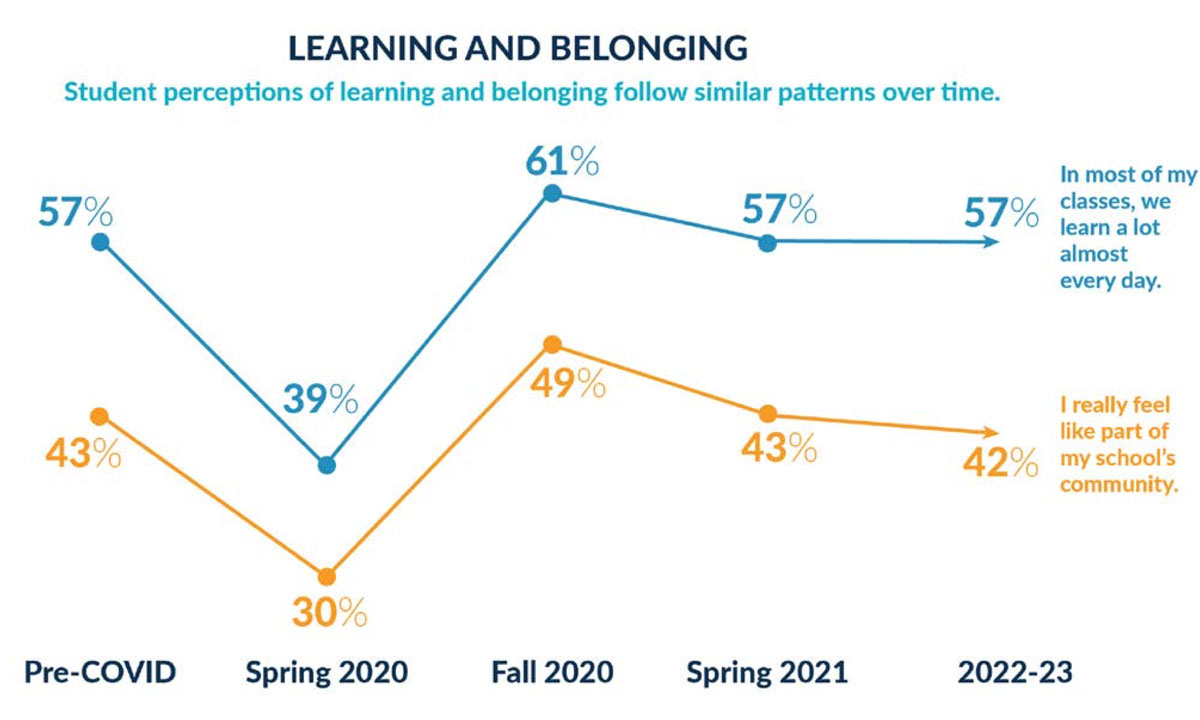How Are Kids Really Doing after COVID-19? Survey of 500K Students Has Answers
Wilka: Perceptions of learning and belonging are back to normal; depression, stress, anxiety make it hard for young people to do their best in school.

Get stories like this delivered straight to your inbox. Sign up for The 74 Newsletter
The back-to-school scene as I dropped my daughter off for her first day of school today was delightfully, if unnervingly, normal. For parents around the country, this is the first back-to-school season since the end of COVID-19 as a public health emergency, and that is something to celebrate. As the country emerges from a pandemic that upended schools and students’ lives, educators and policymakers are lamenting widespread learning losses. But the narrow focus on academic performance is obscuring a larger crisis and missing the bigger picture about how young people are faring and what they need moving forward.
As students head back to school this fall, how are they really doing in the aftermath of COVID-19?
My organization, YouthTruth, a nonprofit that elevates student voices to help schools improve, set out to answer this question by consulting the experts: students themselves. We analyzed quantitative and qualitative feedback data from over 500,000 middle and high school students gathered before, during and after the pandemic. From that data, we learned that student perceptions of learning and belonging in the 2022-23 school year returned to pre-pandemic levels — though troubling differences across student demographic groups remain, with LGBTQ+ students and students of color rating their sense of belonging less positively than their peers. Concerningly, however, students’ experiences with mental health and support from adults in school that worsened during COVID-19 have not recovered.
The most positive of the findings: Young people’s perceptions of learning and belonging followed similar patterns over the course of the pandemic, and both have bounced back to pre-COVID levels, according to the students.
Nonetheless, there remains much room for improvement. Only 42% of students say they feel like a real part of their school’s community. This matters both because of its intrinsic value – young people deserve to feel like they belong — and because belonging is foundational to learning and can catalyze students’ motivation to learn.
Nearly half of all students surveyed in the 2022-23 school year reported that depression, stress or anxiety makes it hard for them to do their best in school. This proportion had increased steadily over the course of the pandemic, from 39% in spring 2020 to 48% in 2022-23. Meanwhile, the proportion of students saying there is an adult at school they can talk to when feeling upset, stressed or having problems decreased to just 41% in the 2022-23 school year from 46% pre-COVID.
This support gap, created by the simultaneous rise in students’ mental health as an obstacle to learning and decline in support from adults at school, emerged in fall 2020. It has since widened, despite significant attention to COVID’s impact on youth depression, anxiety and mental health. Students in our surveys say there are not enough counselors and ask that their schools increase their efforts to reach out to students, to make the help they need “more accessible and clear” rather than just “pushing it under the surface.” The bottom line is that young people’s challenges with mental health and insufficient support are not getting better — not yet, anyway. And these challenges directly impact students’ ability to learn.
Amid this alarming mental health crisis and plummeting NAEP scores, the national narrative on learning loss is limited. The obsession with test scores, the pressure to catch up and one-dimensional accountability systems crowd out other integral sources of feedback about how students are doing. The world is taking shape around this younger generation, and decisions are being made about their future. Yet, far too often, their voices are ignored.
Students are telling the country in no uncertain terms that education doesn’t happen in a vacuum. Social, emotional and academic learning are intrinsically linked, and it can progress only so far when these pieces are separated. This has always been true but is especially so now.
Students are imploring adults in and around schools not to go back to business as usual. In some of their own words: “Put us before test scores.” “Work alongside us.” “Actually listen to us.” As educators, administrators and policymakers move forward in this next chapter, they should remember that students are whole people who need whole solutions to succeed in school and in life. Part of the solution must be truly listening to them.
Get stories like these delivered straight to your inbox. Sign up for The 74 Newsletter

;)
